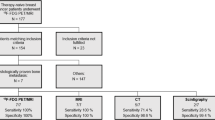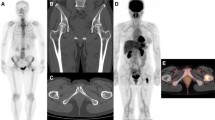Abstract
Objective
To perform a meta-analysis comparing the diagnostic value of 18FDG-PET, MRI, and bone scintigraphy (BS) in detecting bone metastases in patients with breast cancer.
Materials and Methods
MEDLINE, EMBASE, Scopus, ScienceDirect, SpringerLink, Web of Knowledge, EBSCO, and the Cochrane Database of Systematic Review databases were searched for relevant original articles published from January 1995 to January 2010. Inclusion criteria was as follows: 18FDG-PET, MRI or 99mTc-MDP BS was performed to detect bone metastases (the number of published CT studies was inadequate for meta-analysis and therefore could not be included in this study); sufficient data were presented to construct a 2 × 2 contingency table; histopathological analysis and/or close clinical and imaging follow-up for at least 6 months were used as the reference standard. Two reviewers independently assessed potentially eligible studies and extracted relevant data. A software program called “META-DiSc” was used to obtain the pooled estimates for sensitivity, specificity, diagnostic odds ratio (DOR), summary receiver operating characteristic (SROC) curves, and the *Q index for each modality.
Results
Thirteen articles consisting of 23 studies fulfilled all inclusion criteria. On a per-patient basis, the pooled sensitivity estimates for MRI (97.1%) were significantly higher than those for PET (83.3%) and BS (87.0%; P <0.05). There was no significant difference between PET and BS (P <0.05). The pooled specificity estimates for PET (94.5%) and MRI (97.0%) were both significantly higher than those for BS (88.1%; P <0.05). There was no significant difference between PET and MRI (P >0.05). The pooled DOR estimates for MRI (298.5) were significantly higher than those for PET (82.1%) and BS (49.3%; P <0.05). There was no significant difference between PET and BS (P >0.05). The SROC curve for MRI showed better diagnostic accuracy than those for PET and BS. The SROC curve for PET was better than that for BS. The*Q index for MRI (0.935), PET (0.922), and BS (0.872) showed no significant difference (P ≥0.05). On a per-lesion basis, the pooled sensitivity estimates for BS (87.8%) were significantly higher than those for PET (52.7%; P <0.05). The pooled specificity estimates for PET (99.6%) were significantly higher than those for BS (96.1%; P <0.05).The pooled DOR estimates for PET (283.3) were significantly higher than those for BS (66.8%; P <0.05). The SROC curve for PET showed better diagnostic accuracy than that for BS. The*Q index for PET (0.941) was significantly higher than that for BS (0.893; P <0.05).
Conclusion
Magnetic resonance imaging was found to be better than 18FDG-PET and BS for diagnosis of bone metastases in patients with breast cancer on a per-patient basis. On a per-lesion basis, 18FDG-PET had lower sensitivity, higher specificity, a higher DOR, and a higher *Q index than BS.


Similar content being viewed by others
References
Jemal A, Siegel R, Ward E, et al. Cancer statistics 2008. CA Cancer J Clin. 2008;58:71–96.
Coleman RE, Rubens RD. The clinical course of bone metastases from breast cancer. Br J Cancer. 1987;55:61–6.
Ahmed A, Glynne-Jones R, Ell PJ. Skeletal scintigraphy in carcinoma of the breast—a ten year retrospective study of 389 patients. Nucl Med Commun. 1990;11:421–6.
Hortobagyi GN, Theriault RL, Lipton A, et al. Long-term prevention of skeletal complications of metastatic breast cancer with pamidronate: Protocol 19 Aredia Breast Cancer Study Group. J Clin Oncol. 1998;16:2038–44.
Rubens RD. Bone metastases: the clinical problem. Eur J Cancer. 1998;34:210–3.
Even-Sapir E. Imaging of malignant bone involvement by morphologic, scintigraphic, and hybrid modalities*. J Nucl Med. 2005;46:1356–67.
Rybak LD, Rosenthal DI. Radiological imaging for the diagnosis of bone metastases. Q J Nucl Med. 2001;45:53–64.
Van Houwelingen HC, Zwinderman KH, Stijnen T. A bivariate approach to meta-analysis. Stat Med. 1993;12:2273–84.
Van Houwelingen HC, Arends LR, Stijnen T. Advanced methods in meta-analysis: multivariate approach and meta-regression. Stat Med. 2002;21:589–624.
Deville WL, Bezemer PD, Bouter LM. Publications on diagnostic test evaluation in family medicine journals: an optimal search strategy. J Clin Epidemiol. 2000;53:65–9.
Whiting P, Rutjes AW, Reitsma JB, et al. The development of QUADAS: a tool for the quality assessment of studies of diagnostic accuracy included in systematic reviews. BMC Med Res Methodol 2003; 3:25. http://www.biomedcentral.com/1471-2288/3/25. Published November 10, 2003.
Berlin JA. Does blinding of readers affect the results of meta-analyses? University of Pennsylvania Meta-analysis Blinding Study Group. Lancet. 1997;350:185–6.
Zamora J, Abraira V, Muriel A, et al. Meta-DiSc: a software for meta-analysis of test accuracy data. BMC Med Res Methodol. 2006;6:31.
Yip CH, Paramsothy M. Value of routine 99mTc-MDP bone scintigraphy in the detection of occult skeletal metastases in women with primary breast cancer. Breast. 1999;8:267–9.
Schirrmeister H, Guhlmann A, Kotzerke J, et al. Early detection and accurate description of extent of metastatic bone disease in breast cancer with fluoride ion and positron emission tomography. J Clin Oncol. 1999;17:2381–9.
Layer G, Steudel A, Schuller H, et al. Magnetic resonance imaging to detect bone marrow metastases in the initial staging of small cell lung carcinoma and breast carcinoma. Cancer. 1999;85:1004–9.
Altehoefer C, Ghanem N, Hogerle S, et al. Comparative detectability of bone metastases and impact on therapy of magnetic resonance imaging and bone scintigraphy in patients with breast cancer. Eur J Radiol. 2001;40:16–23.
Ohta M, Tokuda Y, Suzuki Y, et al. Whole body PET for the evaluation of bony metastases in patients with breast cancer: comparison with 99Tcm-MDP bone scintigraphy. Nucl Med Commun. 2001;22:875–9.
Yang SN, Liang JA, Lin FJ, et al. Comparing whole body 18F-2-deoxyglucose positron emission tomography and technetium-99m methylene diphosphonate bone scan to detect bone metastases in patients with breast cancer. J Cancer Res Clin Oncol. 2002;128:325–8.
Prior JO, Barghouth G, Delaloye JF, et al. The value of bone marrow scintigraphy using 99mTc monoclonal antigranulocyte antibodies in complement to bone scintigraphy in detecting bone metastases from primary breast cancer. Nucl Med Commun. 2003;24:29–36.
Bossche BVD, Dhaeninck E, Winter FD, et al. 99mTc depreotide scan compared with 99mTc-MDP bone scintigraphy for the detection of bone metastases and prediction of response to hormonal treatment in patients with breast cancer. Nucl Med Commun. 2004;25:787–92.
Engelhard K, Hollenbach HP, Wohlfart K, et al. Comparison of whole-body MRI with automatic moving table technique and bone scintigraphy for screening for bone metastases in patients with breast cancer. Eur Radiol. 2004;14:99–105.
Abe K, Sasaki M, Kuwabara Y, et al. Comparison of 18FDG-PET with 99mTc-HMDP scintigraphy for the detection of bone metastases in patients with breast cancer. Ann Nucl Med. 2005;19:573–9.
Nakai T, Okuyama C, Kubota T, et al. Pitfalls of FDG-PET for the diagnosis of osteoblastic bone metastases in patients with breast cancer. Eur J Nucl Med Mol Imaging. 2005;32:1253–8.
Uematsu T, Yuen S, Yukisawa S, et al. Comparison of FDG PET and SPECT for detection of bone metastases in breast cancer. AJR Am J Roentgenol. 2004;184:1266–73.
Bistow AR, Agrawal A, Evans AJ, et al. Can computerised tomography replace bone scintigraphy in detecting bone metastases from breast cancer? A prospective study. Breast. 2008;17:100–5.
Bossuyt PM, Reitsma JB, Bruns DE, et al. Towards complete and accurate reporting of studies of diagnostic accuracy: the STARD initiative. Radiology. 2003;226:24–8.
Tryciecky EW, Gottschalk A, Ludema K. Oncologic imaging: interactions of nuclear medicine with CT and MRI using the bone scan as a model. Semin Nucl Med. 1997;27:142–51.
Taira A, Herfkens RJ, Gambhir SS, et al. Detection of bone metastases: assessment of integrated FDG PET/CT Imaging. Radiology. 2007;243:204–11.
Liu N, Ma L, Zhou W, et al. Bone metastasis in patients with non-small cell lung cancer: The diagnostic role of F-18 FDG PET/CT. Eur J Radiol. 2010;74:231–5.
Liu FY, Yen TC, Chen MY, et al. Detection of hematogenous bone metastasis in cervical cancer: 18F-Fluorodeoxyglucose-positron emission tomography versus computed tomography and magnetic resonance imaging. Cancer. 2009;115:5470–80.
Heusner T, Golitz P, Hamami M, et al. “One-stop-shop” staging: should we prefer FDG-PET/CT or MRI for the detection of bone metastases? Eur J Radiol. 2009; doi: 10.1016/j.ejrad.2009.10.031.
Kruger S, Buck AK, Mottaghy FM, et al. Detection of bone metastases in patients with lung cancer: 99mTc-MDP planar bone scintigraphy, 18F-fluoride PET or 18F-FDG PET/CT. Eur J Nucl Med Mol Imaging. 2009;36:1807–12.
Cook GJ, Houston S, Rubens R, Maisey MN, Fogelman I. Detection of bone metastases in breast cancer by 18FDG PET: differing metabolic activity in osteoblastic and osteolytic lesions. J Clin Oncol. 1998;16:3375–9.
Peterson JJ, Kransdorf MJ, O’Connor MI. Diagnosis of occult bone metastases: positron emission tomography. Clin Orthop. 2003;415 Suppl:S120–8.
Galasko CS. Mechanisms of lytic and blastic metastatic disease of bone. Clin Orthop. 1982;169:20–7.
Von Schulthess GK. Molecular anatomic imaging: PET-CT and SPECT-CT integrated modality imaging. Philadelphia: Lippincott Williams and Wilkins, 2007; p 452.
Hamaoka T, Madewell JE, Podoloff DA, Hortobagyi GN, Ueno NT. Bone imaging in metastatic breast cancer. J Clin Oncol. 2004;22:2942–53.
Blake GM, Park-Holohan SJ, Cook GJ, Fogelman I. Quantitative studies of bone with the use of 18F-fluoride and 99mTc-methylene diphosphonate. Semin Nucl Med. 2001;31:28–49.
Cook GJ, Fogelman I. The role of positron emission tomography in the management of bone metastases. Cancer. 2000;88:2927–33.
Loeffler RK, DiSimone RN, Howland WJ. Limitations of bone scanning in clinical oncology. JAMA. 1975;234:1228–32.
Muindi J, Coombes RC, Golding S, et al. The role of computed tomography in the detection of bone metastases in breast cancer patients. Br J Radiol. 1983;56:233–6.
Karnholz R, Sze G. Current imaging in spinal metastatic disease. Semin Oncol. 1991;18:158–69.
Vogler 3rd JB, Murphy WA. Bone marrow imaging. Radiology. 1988;168:679–93.
Acknowledgements
No funds were received in support of this study. No benefits in any form have been or will be received from a commercial party related directly or indirectly to subject matter of this manuscript.
Conflict of interest
None.
Author information
Authors and Affiliations
Corresponding author
Additional information
Tao Liu and Tao Cheng contributed equally to this work as the first authors
Rights and permissions
About this article
Cite this article
Liu, T., Cheng, T., Xu, W. et al. A meta-analysis of 18FDG-PET, MRI and bone scintigraphy for diagnosis of bone metastases in patients with breast cancer. Skeletal Radiol 40, 523–531 (2011). https://doi.org/10.1007/s00256-010-0963-8
Received:
Revised:
Accepted:
Published:
Issue Date:
DOI: https://doi.org/10.1007/s00256-010-0963-8




